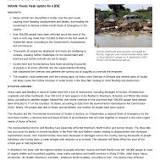Feature: Battling cervical cancer, a survivor's tale.


CLOSE to 2000 women die every year from cervical cancer alone in Zimbabwe while 3043 new cases are diagnosed. This is despite the fact that the disease is preventable and treatable if detected early.
Susan Katuruza (36) a nurse by profession is one of the lucky ones who lived to see another day and tell their tale in the fight against cervical cancer.
Katuruza hopes that telling her story will encourage those battling the disease, and raise awareness on how early screening and getting treatment early is key to treating the malignant disease.
“I started observing some unusual signs mid last year. It started with a copious amount of discharge which required me to frequently change my under garments,” she recalls.
Katuruza got very concerned about the new developments and approached her gynaecologist who examined her and noticed some lesions.
“A piece of flesh was taken to the laboratory for further analysis. It is called a histology specimen,”
It was on a Saturday, meaning she had to endure the whole weekend wondering what would come out of the diagnosis.
She spent the whole weekend googling for some comforting information, a sign of denial.
When the results came back Katuruza got the shock of her life and her whole world came crashing around her.
“The specimen results indicated that I had cancer of the cervix. That alone devastated me. I was very worried,”
Although the doctor had earlier on hinted that it could be cancer, nothing could have prepared her for the positive results.
This was in the midst of the virulent Delta variant which was tearing into health facilities nations and decimating families.
“I was shattered and to me that was the end of life and I could no longer proceed with the plans that I had for my family and my work,”.
Katuruza”s maternal family has a history of cervical cancer and that predisposed her to infection.
“My mother and my aunts cried because they had witnessed my great grandmother and my grandmother suffering from cervical cancer, and resultantly dying from it. Back then treatment options were limited,” she said.
The treatment
Katuruza was determined to live and beat this disease which had robbed her clan of women.
“I was referred to an oncologist at Parirenyatwa and was told that the outcomes of cancer treatment like chemotherapy and radiotherapy were effective.”
Her journey was marred by periods of anxiety. As she was a nurse, she started imagining what the drugs would do to her, including side effects like loss of hair and loss of weight.
“I also knew the treatment would make me vulnerable to other infections and that concerned me,” she said.
Her mother however became her pillar of strength ensuring that she ate healthy foods and ate frequently.
“I took my chemo and radiotherapy sessions well, dealing with each day as it comes. I stopped referring to google for comfort.”
She remained vigilant with treatment cycles and did not slacken.
Her colleagues were actually more worried about her but she assured everyone that she would beat the disease back to Mars.
“Many thought I was going to die. It was not easy for me. As a nurse, I found myself on the other side of the bed.”
But sheer determination and a vigilant treatment regime saw her through the dark maze and she survived to tell her story.
Key lessons and advice
“Being a nurse or health professional does not exempt you from getting such a dreadful disease. I had to become a lay person and follow all the instructions,” she said.
Katuruza also believes the key is in getting screened early and watching out for unusual signs and symptoms and getting them checked out.
“Listen to your body. If you see anything, try and report it early. It can save your life.”
She said there were various screening options like the Visual Inspection with Acetic Acid and Camera (VIAC) as well as DNA HPV.
VIAC is an effective way to prevent cervical cancer in women. It was introduced in 2012 in Zimbabwe and is offered for free at public health facilities.
It involves examining the opening of the womb, or the cervix, for changes that might lead to cancer. If these changes are detected early, the cells can be eliminated before they become cancerous. The cells are usually removed using a method called cryotherapy, or another method called LEEP.
The DNA-based testing for human papillomavirus (HPV) has also been shown to be more effective. Last year in October, the World Health Organisation recommended it as the first choice screening method.
For younger girls; getting them vaccinated against the disease is a better option.
Katuruza also warned women against applying and inserting foreign objects in their genitalia.
“Those herbs which allegedly enhance pleasure can actually predispose a woman to getting infected.
Meanwhile, health experts have urged women to take advantage of the screening and treatment options as well as the vaccination for the younger girls.
Speaking during a recently held cervical cancer awareness meeting convened by Cancercare network with support from generation health, Charity Chipfumbu from Population Services International said almost all cervical cancers are caused by HPV which can be passed from one person to another during intimacy.
“Cancer is preventable and treatable if detected early, “she said.
Gynaecological oncologist Bothwell Guzha said HPV vaccination for young girls was critical. For those under 14 they would require two doses of injections while those aged 15 and above would require three doses.


 United Kingdom
United Kingdom Argentina
Argentina  Australia
Australia  Austria
Austria  Brazil
Brazil  Canada
Canada  Germany
Germany  Ireland
Ireland  Italy
Italy  Malaysia
Malaysia  Mexico
Mexico  New Zealand
New Zealand  Poland
Poland  South Africa
South Africa  United States
United States 























